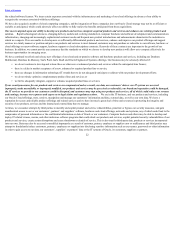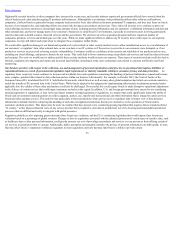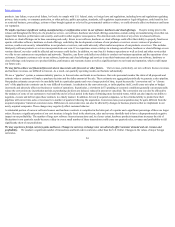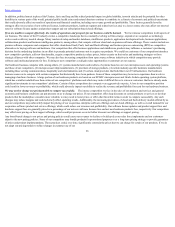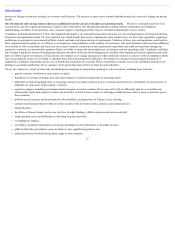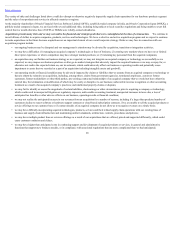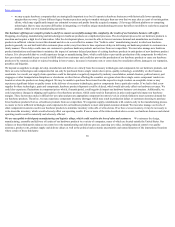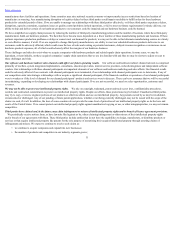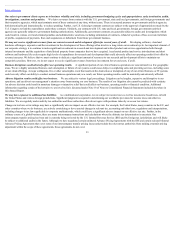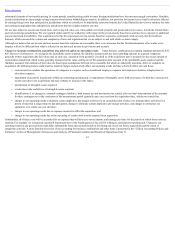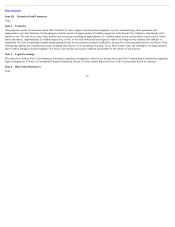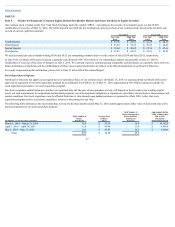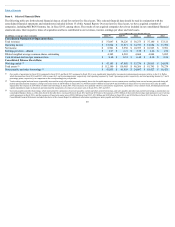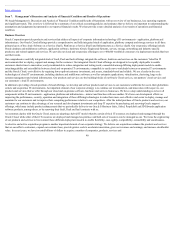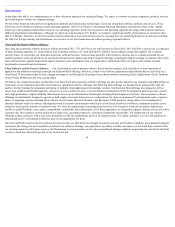Oracle 2015 Annual Report Download - page 34
Download and view the complete annual report
Please find page 34 of the 2015 Oracle annual report below. You can navigate through the pages in the report by either clicking on the pages listed below, or by using the keyword search tool below to find specific information within the annual report.
Table of Contents
• the use and support of third-party code (including open source code) becomes more prevalent in the industry;
• the volume of issued patents continues to increase; and
• the proliferation of non-practicing entities asserting intellectual property infringement claims increases.
Responding to any such claim, regardless of its validity, could:
• be time consuming, costly and result in litigation;
• divert management’s time and attention from developing our business;
• require us to pay monetary damages or enter into royalty and licensing agreements that we would not normally find acceptable;
• require us to stop selling or to redesign certain of our products;
• require us to release source code to third parties, possibly under open source license terms;
• require us to satisfy indemnification obligations to our customers; or
• otherwise adversely affect our business, results of operations, financial condition or cash flows.
Our periodic workforce restructurings, including reorganizations of our sales force, can be disruptive. We have in the past restructured or made other
adjustments to our workforce, including our direct sales force on which we rely heavily, in response to management changes, product changes, performance issues,
change in strategies, acquisitions and other internal and external considerations. In the past, these types of sales force restructurings have resulted in increased
restructuring costs, increased sales and marketing costs and temporary reduced productivity while the sales teams adjusted to their new roles and responsibilities. In
addition, we may not achieve or sustain the expected growth or cost savings benefits of these restructurings, or do so within the expected timeframe. These effects
could recur in connection with future acquisitions and other restructurings and our revenues and other results of operations could be negatively affected.
We may lose key employees or may be unable to hire enough qualified employees. We rely on hiring qualified employees and the continued service of our
senior management, including our Chairman of the Board of Directors, Chief Technology Officer and founder, our Chief Executive Officers, other members of our
executive team and other key employees. In the technology industry, there is substantial and continuous competition for highly skilled business, product
development, technical and other personnel. We may also experience increased compensation costs that are not offset by either improved productivity or higher
sales. We may not be successful in recruiting new personnel and in retaining and motivating existing personnel. With rare exceptions, we do not have long-term
employment or non-competition agreements with our employees. Members of our senior management team have left Oracle over the years for a variety of reasons,
and we cannot assure you that there will not be additional departures, which may be disruptive to our operations.
We continually focus on improving our cost structure by hiring personnel in countries where advanced technical expertise and other expertise are available at lower
costs. When we make adjustments to our workforce, we may incur expenses associated with workforce reductions that delay the benefit of a more efficient
workforce structure. We may also experience increased competition for employees in these countries as the trend toward globalization continues, which may affect
our employee retention efforts and increase our expenses in an effort to offer a competitive compensation program.
Our general compensation program includes restricted stock units, performance stock units and stock options, which are important tools in attracting and retaining
employees in our industry. If our stock price performs poorly, it may adversely affect our ability to retain or attract employees. We continually evaluate our
compensation practices and consider changes from time to time, such as reducing the number of employees granted equity awards or the number of equity awards
granted per employee and granting alternative forms of stock-based compensation, which may have an impact on our ability to retain employees and the amount of
stock-based compensation expense that we record. Any changes in our compensation practices or those of our competitors could affect our ability to retain and
motivate existing personnel and recruit new personnel.
32


